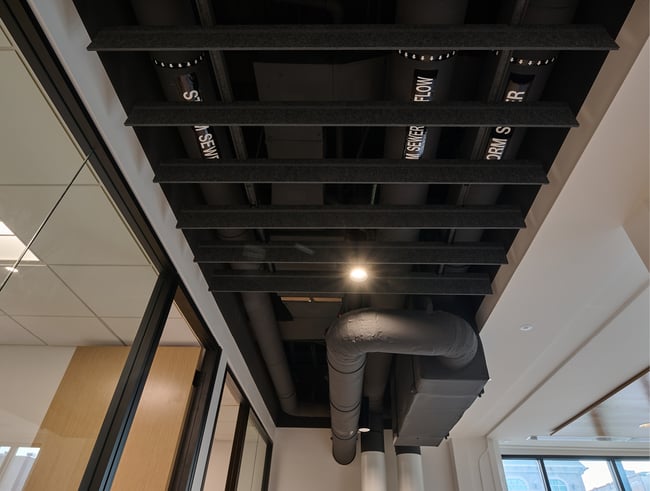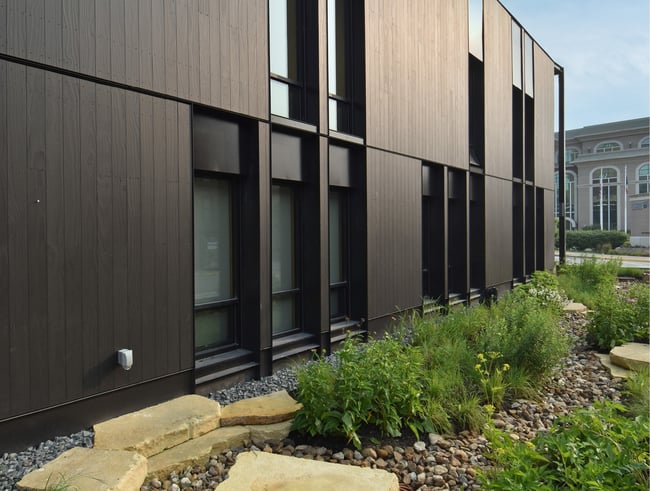Water as Precious Resource: The LBC Water Petal at the Stanley Center

Water scarcity is a serious issue across the globe, with many areas facing severe shortages and compromised quality. Even areas with abundant precipitation are at-risk due to climate change and the continued use of aquifers.
Addressing water scarcity requires a new approach to collecting, treating, and managing this resource. The Living Building Challenge (LBC)—a third-party building verification system—provides one path forward. Its Water Petal promotes water systems based on available resources and localized treatment.
In Muscatine, Iowa, the Stanley Center for Peace and Security’s new headquarters is tracking to be the second renovation to become a fully certified Living Building. Following the Water Petal’s guidelines, the building collects and stores all its potable and non-potable water needs on-site.
To celebrate this achievement, we are discussing how the building fulfills each LBC Petal. This article will explain the Water Petal, its imperatives, and the solutions implemented at the Stanley Center.
Understanding the Water Petal
The LBC is the most rigorous approach to sustainability within the built environment. Its framework is broken into seven categories known as “Petals” which include:
- Place
- Water
- Energy
- Health and Happiness
- Materials
- Equity
- Beauty
The Water Petal addresses how we transport, purify, and treat water, as well as its downstream impacts on human health and the environment. Each LBC petal is broken into separate requirements called imperatives. The Water Petal has two: Net Positive Water and Responsible Water Use.
The Net Positive Water imperative encourages projects to use a closed-loop system where all the building’s water needs are met through captured precipitation and recycled wastewater.
Responsible Water Use encourages projects to treat water as a precious resource and minimize waste. Projects cannot use potable water for irrigation and must use less water for other uses than baseline regional standards.
Water Petal at the Stanley Center
The Water Petal was one of the most challenging aspects of the Stanley Center project. Its encouraged practices are uncommon, requiring additional city approvals.
At the same time, on-site wastewater treatment doesn't always align with the project’s goals or the regional conditions. As such, the team opted for a strategy called “handprinting” to offset wastewater.
Collecting Water On-Site
At the Stanley Center’s headquarters, all potable and non-potable water is collected on-site through precipitation. In the project’s early stages, our partners at Environmental Consulting Technologies calculated the building’s expected water usage, and Biohabitats designed the system to these specifications.
Rainfall collects on the rooftop and flows through a first-stage filtration system before being stored in two 6,750-gallon cisterns. The cisterns were deliberately placed on the street rather than buried underground to draw attention to this unique system.

Water flows through this first-stage filtration system before entering cisterns.
Inside the insulated cisterns, water is recirculated to prevent freezing during winter months. The water then flows through a filtration system and into pressurized tanks within the building where it can then be used in sinks, toilets, or irrigation systems.
Generally, LBC projects recycle water, with graywater used for non-potable purposes. Wastewater, called blackwater, can be filtered and polished through artificial wetland systems.
Although the team explored these approaches, it did not make sense to fully create a closed-loop system. The building site is in a region rich in water, and on-site wastewater treatment was costly. Instead, a handprinting approach seemed to best align with the project’s goals and location.
Handprinting
Handprinting is a strategy within the LBC framework where a project offsets its water usage through deliberate, local action.
At the Stanley Center’s headquarters, gray and blackwater flow into the municipal system. To offset this waste, the Stanley Center partnered with the Muscatine Center for Social Action (MCSA) to replace their facility’s plumbing fixtures with low-flow alternatives.
Calculations helped to determine the most impactful places to invest, and the team replaced washing machines, toilets, and showerheads at MCSA’s facility. Previous fixtures were aging and used a lot of water, but replacement wouldn’t have been possible given funding limits.
In the end, the handprinting approach was a net zero add, reducing the amount of wastewater entering the municipal sewer system even after the Stanley Center became operational. This approach was an opportunity to assist a local non-profit while still meeting LBC requirements—a win, win. It also served as a valuable educational tool, showing others how they can apply the LBC’s requirements within our region.
Managing Stormwater
The building’s site also manages stormwater responsibly. Most of the rainwater collected on the roof is collected in the cisterns for use.
When the cisterns are full, overflow water is sent through an underground pipe system, referenced by a paver pattern at the entry. It is then deposited into a large bioswale area that wraps the building’s southeast corner where it can percolate into the ground.
Typically, rainfall flows into municipal stormwater systems. Heavy rain events can overload these systems, leading to flood control issues and drinking water contamination from runoff.

Bioswales capture stormwater, allowing it to naturally percolate into the soil.
Bioswales, on the other hand, act as a kind of sponge, allowing water to absorb into the soil naturally. Such spaces can also act as pollinator habitats and aid biodiversity. The Stanley Center’s bioswales contain nearly 20 plant species native to Muscatine County, compared to typical urban prairie restorations containing about five species.
Permeable pavers beneath the entry also capture rainfall, preventing runoff that can pollute drinking water. Trees along the sidewalk further benefit the community by creating more spaces for stormwater to drain.
Learn More About the Living Building Challenge
The Water Petal is one of the most challenging aspects of the LBC. Its practices are unconventional, often at odds with municipal building codes and accepted approaches to design and construction. However, this radical departure from convention helps us reassess our relationship with water and develop solutions that improve resiliency in the face of climate change.
At the Stanley Center, water use is based on the carrying capacity of the site. Water for drinking, washing dishes, flushing toilets, and irrigating agriculture comes from on-site rainfall. By partnering with MSCA, the Center was able to offset the volume of water sent to the municipal sewer system.
With heavy summer rains, the building’s water cisterns are currently full. As the Stanley Center embarks on its first operational year, we will continue monitoring the system’s efficiency.
The LBC is the most rigorous and holistic approach to sustainable design and construction. In our experience, it requires an integrated project team and an inclusive design process. Determine if its framework fits your goals by reading about the questions to ask before pursuing the LBC.